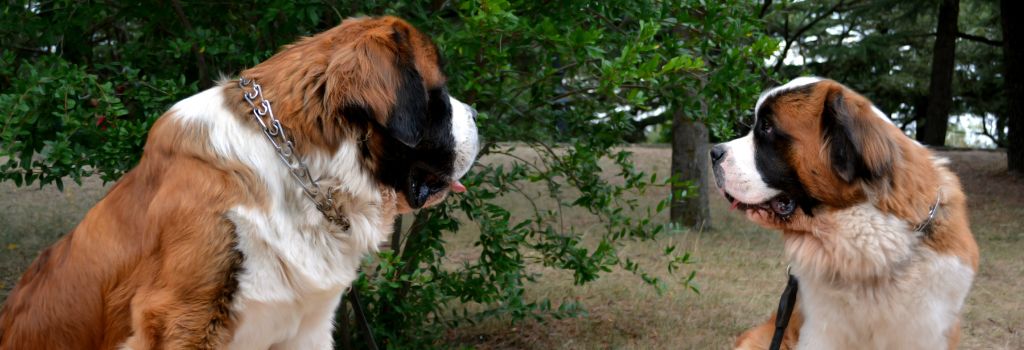If you've welcomed a Saint Bernard into your life, you've undoubtedly realized that your home is now graced with a gentle giant full of love and good intentions. These large, affectionate dogs bring a unique blend of traits to your life that can make them invaluable family members. Here's what you can expect from your Saint Bernard and how to provide the best care for them.
Why They are Saints:
- A Lovable Companion: Saint Bernards are well-known for their easygoing and lovable nature. They are extremely affectionate and get along wonderfully with children and other pets, making them excellent family companions.
- Eager to Learn: These giants are more than just a pretty face; they're also intelligent and very responsive to training. Their eagerness to please makes them a joy to work with when it comes to learning new tricks or obedience skills.
- The Brave Adventurer: Originally bred for rescue work in the Swiss and Italian Alps, Saint Bernards carry that brave and adventurous spirit within them. They're always ready for an outing and are known to be protective of their families.
- Devoted and Friendly: Saint Bernards form strong bonds with their human family members and are exceptionally loyal. They are naturally friendly, exuding warmth and kindness to those they meet.

The Flip Side: Challenges to Consider
While Saint Bernards bring a lot of love and companionship, they also come with their own set of challenges. For starters, their large size means they require space to move around. You'll also need to ensure they get daily exercise to keep them happy and healthy.
They don't fare well in hot climates and can become bored and anxious when left alone for extended periods. Their massive bodies are prone to passing gas, shedding, and drooling, so be prepared for some clean-up duties.
History and Heritage
The Saint Bernard originated as a rescue dog, trained by monks to save travelers in the Alps. Their dense, protective coats can be either long or short and are designed to keep them warm in frigid temperatures. This breed is known for its patience and tolerance, especially with children, and can become quick defenders if their family is ever threatened.
Health and Longevity
While they are generally healthy, Saint Bernards have a shorter lifespan compared to other breeds, averaging around 8-9 years. Regular veterinary care is essential to monitor any potential health issues specific to this large breed.
So, is a Saint Bernard the right fit for your family? If you're prepared for the challenges their size and needs bring, and you're looking for an affectionate, loyal companion, then the answer is a resounding yes. With proper care and attention, your Saint Bernard will enrich your life in countless ways.

Genetic Predispositions for Saint Bernards
When Your St. Bernard's Tummy Takes a Twirl: Understanding Bloat
Let's talk about something a bit scary but super important: Gastric Dilatation and Volvulus (GDV), commonly known as bloat. This condition loves to target dogs with deep, narrow chests—like our beautiful St. Bernards. Picture this: the stomach twists and fills with gas, which not only sounds painful but is incredibly dangerous. It cuts off the blood supply to the stomach and sometimes even the spleen. Without quick treatment, this could be fatal in as little as half an hour. Signs? Your pooch might retch or heave without anything coming out, appear restless, or assume a prayer-like position. Prevention is key, and surgery is an option to keep the stomach in place. But if symptoms appear, rush to the vet immediately. Time is of the essence!
Heart-to-Heart about Cardiac Care: The Risk of DCM in Saint Bernards
If you've got a St. Bernard, you've got a lot of love in a big package. But sadly, these gentle giants are prone to a severe heart condition known as dilated cardiomyopathy (DCM). Imagine a heart so large and weak that it struggles to pump blood. Yep, it's as bad as it sounds. Early signs may include weakness, labored breathing, fainting, or even collapsing. The good news? Early detection is possible through yearly ECGs and/or echocardiograms. Medication and dietary supplements can manage this condition effectively if caught early. Keep an eye out for symptoms and stick to those vet appointments!
All About Those Peepers: Eye Conditions in Saint Bernards
We all love looking into our dog’s soulful eyes, don't we? Especially when those eyes belong to a Saint Bernard. But it's crucial to know that these beauties can inherit or develop several eye problems. Conditions like cataracts could cloud their vision, and painful issues like entropion or distichiasis might make every blink a struggle. That's why we'll be watching closely during every vet check-up to make sure those eyes are in tip-top shape. And yes, surgery can be an option for more severe cases. So, keep an eye out—pun intended—for any changes in your dog's eyes.
Bone Cancer in Big Breeds: What to Know About Osteosarcoma
We often say our St. Bernards are big-boned, but did you know they're at a higher risk for bone cancer like osteosarcoma? If your furry friend starts limping or shows signs of leg pain, don't shrug it off. Early detection is crucial for effective treatment of this aggressive tumor. Don't wait; call your vet as soon as you notice anything off. Your quick action could make all the difference!

A Flow Issue: Von Willebrand's Disease and Your Saint Bernard
Okay, let's chat about something that may not be on your radar: inherited bleeding disorders. Von Willebrand's Disease, a clotting disorder, can be especially concerning for St. Bernards. Many times, everything seems normal until—bam!—a minor injury or surgery results in excessive bleeding. Before any surgical procedures, a blood clotting time test or a DNA blood test can provide a heads-up, helping to prevent nasty surprises.
Bone and Joint Issues: More Than Just Growing Pains
We know how much you love your fluffy giants, but these sweethearts are prone to certain musculoskeletal issues that you should be aware of. When it comes to growing puppies, slow and steady wins the race! If your St. Bernard pup grows too quickly, they could develop a condition known as osteochondritis dissecans (OCD). Imagine it as a hiccup in the way cartilage attaches to the bones in the joints. But don't stress, surgery can often correct the issue. Just remember to follow a large-breed puppy diet and check their weight every three to four weeks.
Also, keep an eye out for signs of hip and elbow dysplasia. If your pup shows stiffness or lameness, an early diagnosis via X-ray can make a world of difference. Weight management is crucial here, as overweight dogs are more susceptible to arthritis. And let's not forget about knee issues; a torn cranial cruciate ligament needs surgical correction most of the time. Keeping your dog's weight in check and avoiding high-impact activities can help prevent this painful injury. Last but not least, if your St. Bernard starts limping between six and ten months, it could be eosinophilic panosteitis. It’s painful but typically temporary, and a good vet can manage it effectively.
A Closer Look at Epilepsy
Seizures can be quite scary, both for your dog and you. Saint Bernards are more prone to epilepsy, which can manifest in different types of seizures. Whether they are reactive, secondary, or primary (idiopathic), early diagnosis is key. Lifelong medication is generally required, so if you notice symptoms, seek immediate veterinary advice.

Skin Conditions: Not Just Skin-Deep!
With their lush coats, Saint Bernards require regular grooming to prevent matting and potential skin infections like hot spots. But beware of calluses! These hard skin areas can become infected, leading to a condition called callus pyoderma. Maintaining a healthy weight and providing soft bedding can help alleviate this problem. Also, look out for sebaceous adenitis, which results in dry, flaky skin and patchy hair loss. Treatment involves a mix of special shampoos and fatty acid supplements.
The Importance of Calcium Balance
Did you know 98% of your dog's calcium is in their bones? An imbalance, especially in a St. Bernard, can lead to a host of issues. Look out for symptoms like behavioral changes, muscle tremors, and seizures. With the right medications and dietary supplements, managing the condition is quite doable.
Overheating & Malignant Hyperthermia: Handle with Care!
Some St. Bernards have what you might call a 'faulty internal thermostat,' making them prone to malignant hyperthermia. This can be particularly risky during and after anesthesia, so your vet will need to monitor their temperature closely.
Addison’s Disease: The Undercover Illness
Last but not least, there’s Addison's Disease. This sneaky condition mimics other illnesses, making it hard to diagnose. If your Saint Bernard seems lethargic or has unexplained weight loss, ask your vet for a specialized blood test to rule out Addison’s. Once diagnosed, it's often manageable with medication and regular check-ups.
Don't have a vet in your area yet? We can help you find a local veterinarian.
If you have more questions, the GeniusVets Telehealth platform will give you unlimited access to text and/or video calls with board-certified veterinarians! To learn more click here.
